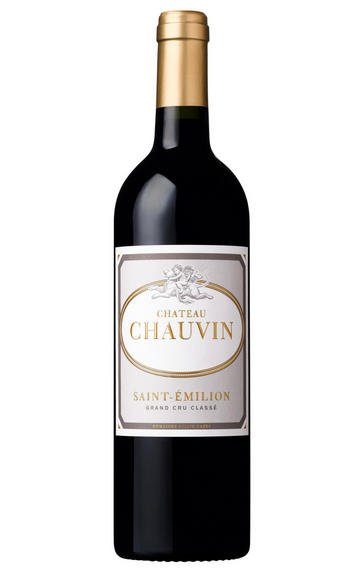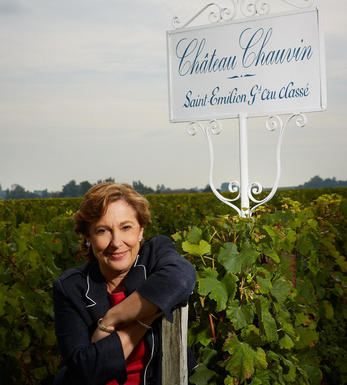
Critics reviews
About this WINE

Chateau Chauvin
Château Chauvin, a St. Emilion Grand Cru Classé, is located in the northwestern part of the St. Emilion appellation. Chauvin has been in the hands of the Ondet family since 1981 and is now owned and managed by Béatrice Ondet and her sister, Marie-France Février. Béatrice is a passionate advocate of women winemakers, claiming that, "wine made by women tastes different, it's more subtle, elegant and complex than wine made by men, which tends to be stronger and more aggressive."
Chauvin is a single vineyard plot with 15 hectares planted with 80% Merlot, 15% Cabernet Franc and 5% Cabernet Sauvignon. The grapes are hand-harvested and then matured in temperature-controlled- stainless steel vats. The wine is then matured in oak barriques (50% new) for 15 months.
Cult oenologist Michel Rolland is a consultant at Chauvin and under his supervision the grapes are now harvested later and a strict selection policy is adhered to when the grapes arrive in the cuverie. The quality of the wine is now at an all-time high.

St Émilion
St Émilion is one of Bordeaux's largest producing appellations, producing more wine than Listrac, Moulis, St Estèphe, Pauillac, St Julien and Margaux put together. St Emilion has been producing wine for longer than the Médoc but its lack of accessibility to Bordeaux's port and market-restricted exports to mainland Europe meant the region initially did not enjoy the commercial success that funded the great châteaux of the Left Bank.
St Émilion itself is the prettiest of Bordeaux's wine towns, perched on top of the steep limestone slopes upon which many of the region's finest vineyards are situated. However, more than half of the appellation's vineyards lie on the plain between the town and the Dordogne River on sandy, alluvial soils with a sprinkling of gravel.
Further diversity is added by a small, complex gravel bed to the north-east of the region on the border with Pomerol. Atypically for St Émilion, this allows Cabernet Franc and, to a lesser extent, Cabernet Sauvignon to prosper and defines the personality of the great wines such as Ch. Cheval Blanc.
In the early 1990s there was an explosion of experimentation and evolution, leading to the rise of the garagistes, producers of deeply-concentrated wines made in very small quantities and offered at high prices. The appellation is also surrounded by four satellite appellations, Montagne, Lussac, Puisseguin and St. Georges, which enjoy a family similarity but not the complexity of the best wines.
St Émilion was first officially classified in 1954, and is the most meritocratic classification system in Bordeaux, as it is regularly amended. The most recent revision of the classification was in 2012

Cabernet Sauvignon Blend
Cabernet Sauvignon lends itself particularly well in blends with Merlot. This is actually the archetypal Bordeaux blend, though in different proportions in the sub-regions and sometimes topped up with Cabernet Franc, Malbec, and Petit Verdot.
In the Médoc and Graves the percentage of Cabernet Sauvignon in the blend can range from 95% (Mouton-Rothschild) to as low as 40%. It is particularly suited to the dry, warm, free- draining, gravel-rich soils and is responsible for the redolent cassis characteristics as well as the depth of colour, tannic structure and pronounced acidity of Médoc wines. However 100% Cabernet Sauvignon wines can be slightly hollow-tasting in the middle palate and Merlot with its generous, fleshy fruit flavours acts as a perfect foil by filling in this cavity.
In St-Emilion and Pomerol, the blends are Merlot dominated as Cabernet Sauvignon can struggle to ripen there - when it is included, it adds structure and body to the wine. Sassicaia is the most famous Bordeaux blend in Italy and has spawned many imitations, whereby the blend is now firmly established in the New World and particularly in California and Australia.



Buying options
Add to wishlist
Description
A superb wine, this opaque purple-coloured effort boasts a vividly pure nose of graphite, melted licorice, creme de cassis, espresso and wet stones backed up by subtle, high quality, spicy new oak. Multi-layered, full-bodied, dense, concentrated and pure with sweet tannin and superb length, this future classic will be at its best between 2008 and 20019. 92/100pts (Robert Parker - Wine Advocate - Apr-2003)
wine at a glance
Delivery and quality guarantee